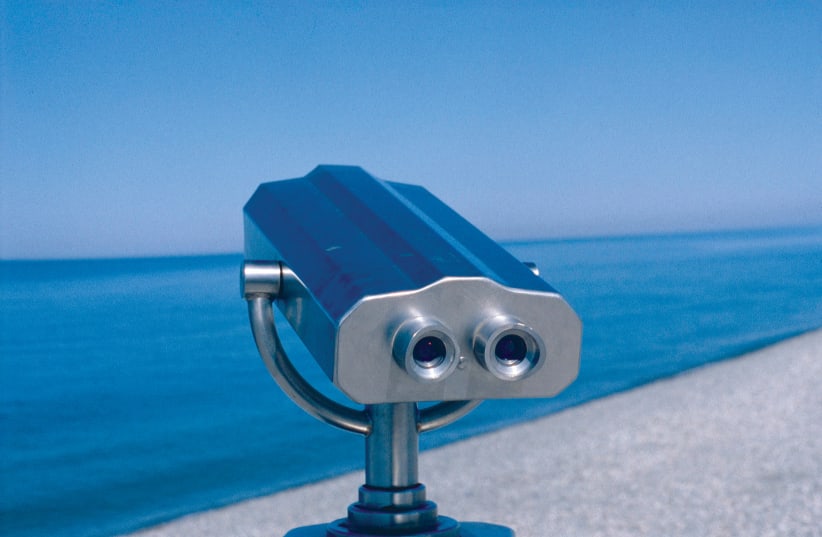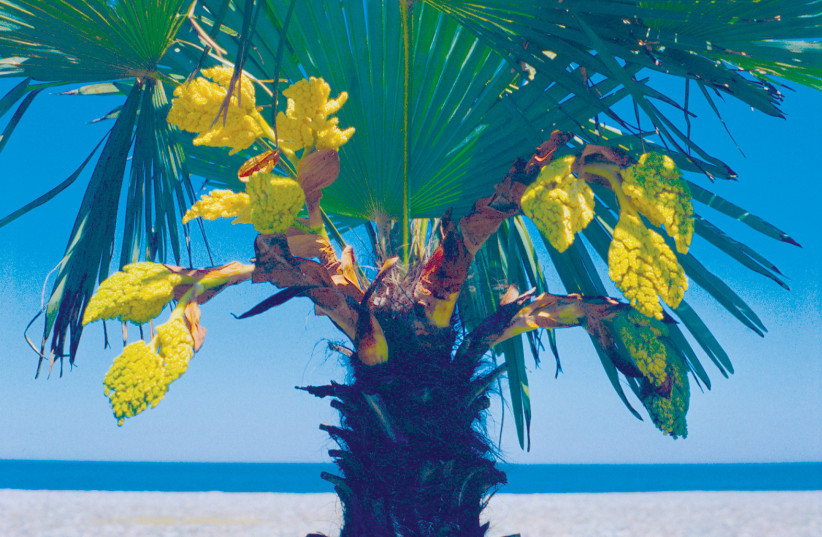The jury is still out on the full impact of the backlash and/or positive results of the past two-and-a-half years. One wonders whether, after being cooped up within our own four walls for extended periods of time, we have come out of that keener to dig into the outside world and experience it in a hands-on or actively sensorial way. Or are we so fired up to get back to “normal” that we have blithely resumed our nine-to-five, home-to-work-to-the-shops routine with a vengeance?
How much notice we take of our surroundings, man-made and natural, lies at the core of an intriguing exhibition currently on display at Art Cube Artists’ Studios in Talpiot as part of this year’s Manofim Jerusalem Contemporary Art Festival, which takes place September 13-17. The exhibition is called “More Images about Architecture and the Sea” and is the brainchild of Vienna-based multidisciplinary artists Aleksandra Kolodziejczyk and Karl Wratschko.
The exhibition comprises new cinematic and photographic works, created between 2020 and 2022, using analogue methods. The works focus on architecture in public spaces and sculptures – some pretty wacky and totally incongruous – in parks, near housing projects and near beachfronts.
And there is some political content in there, such as gender equality issues.
“We were walking around in Vienna, and we saw that in the outskirts you find streets named after women. Places that are very far away, where nobody goes, there you find the streets with women’s names,” Wratschko notes with a wry smile.
“They are very small streets,” Kolodziejczyk joins in. “For example, you can have a street with just one building that is named after a woman.”
That spawned 1/15, a short film – lasting all of three minutes and 23 seconds – which documents all the streets and places in Graz, Austria’s second-largest city, that commemorate female figures. The titular fraction references the ratio between the number of locations in Graz named after men, and after women. Wratschko and Kolodziejczyk were keen to draw our attention to that gender imbalance, which also reflects the way women are acknowledged in society as a whole.
Things aren’t much better over here. A recent book called 50 of Tel Aviv’s Most Intriguing Streets – The Lives Behind the Names also bemoans the paucity of female street names in downtown Tel Aviv and the older parts of the city. It seems Jerusalemites don’t have much to shout about either.
“I also checked in Jerusalem,” says Wratschko, who has been enjoying an artist-in-residence berth here for the past two months. “There are about 50 streets named after women, and most of them are from 2,000 years ago,” he chuckles. “And there are some resistance fighters from 1948. But I think it is 50 compared with something like 1,800 male street names.” That’s way more than the Graz multiple.
“There are about 50 streets named after women, and most of them are from 2,000 years ago. And there are some resistance fighters from 1948. But I think it is 50 compared with something like 1,800 male street names.”
Karl Wratschko
A recurring theme of ecology at the Jerusalem exhibitions
ECOLOGY IS also a recurrent theme across various Manofim exhibitions and also features prominently in the 7th Jerusalem Art Conference, on September 15 and 16, at Hansen House and Shalom Hartman Institute, respectively.
Conference curators and directors Dr. Ronen Eidelman, Yonatan Amir and Rinat Edelstein – the latter is co-founder of Manofim along with Lee He Shulov – have put together an intriguing agenda that looks at the role of art in tackling international and local political, environmental and technological issues.
That sounds like veritable powder keg stuff, tailor made to spark lively discussion and a plethora of ideas and, possibly, emotionally charged opinions. More power to their dialectic arms.
Part of the conference will feed off “Documenta,” the exhibition of contemporary art that takes place in Kassel, Germany, every five years. This year’s edition, the 15th to date, is still in progress. It focuses on such wholesome concepts as collectivity, communal resource sharing and a collaborative approach to life.
That idea was embraced by Edelstein and Shulov, as they aim to push the Manofim venture to ever higher spheres.
“This year we are holding the opening here, on the roof of the building,” Edelstein says proudly.
Fourteen years on, after the country’s leading arts event was launched, the festival finally gets to host its own curtain-raiser.
The collaborative-communal spirit informs much of what Manofim is about.
“The festival has grown a lot over the years,” Shulov notes. “We have a bunch of new projects this year, such as the roof project.” That is very much central to the whole programmatic zeitgeist. “We call the roof project Bustan Ha’aman [the Artist’s Garden].” The fecundity reference is not happenstance. “We want to develop programs in conjunction with communities around us, and people that want to be in contact with us.”
The top of the building appears to provide the perfect venue for conjoining ideas, emotions, lifestyles and, naturally, cultural and artistic endeavor. For starters, the roof provides a great vantage point for taking in the surroundings.
“You can see the whole of Talpiot, and Beit Safafa, Hamesila Park [and] the Katamonim from there,” Edelstein adds.
You can, indeed. It does give you a sense of being at the nodal point of something big, something with numerous strands – cultural, ethnic, creative – to it. In short, Jerusalem.
The roof will act as a sort of facilitating means for communities that don’t possess the financial or structural wherewithal to get on with things on their own.
“This will have artistic and cultural content, and also host sustainability activities,” Shulov explains. “The idea is that it will become a semipublic domain that will be accessible not only to us [at the Artists’ Studios] but also to people living around us.”
The artistic directors are ready and willing to put their money where their mouth is. “For example, in the Katamonim they don’t have a community administration building for [residential] areas A to F. There are loads of activities there, but there is no one venue that serves the local residents. We want to offer the roof as a home, a hosting home, for this kind of thing.”
There is a lot going on in the Manofim lineup, with manifold layers, creative directions, disciplines and lines of thought and, it seems, lots to note, celebrate and promulgate.
One of the major slots in the rooftop itinerary is a salute to Harama, an online publication that has been doing its utmost for a whole decade to spread the word about contemporary artistic doings in the capital, gradually building up a valuable archive in the process. It is not by chance that Edelstein is the guiding hand, expertise and spirit behind the Internet-based magazine.
In an era in which practically nothing moves anywhere on the planet without some degree of technological intervention, it is heartening to see the forthcoming festival edition dip into “old school” means of communication, sonic enterprise and amplification.
Anyone, like yours truly, who prefers the tangible, human-powered route through life rather than the virtual digital razzmatazz superhighway approach to getting things done, will take heart from the Mixer slots dotted through the festival bill.
On September 16, for example, the suitably titled Analog show takes place at Hansen House, thereby bringing the curtain down on the aforementioned two-day conference. The lineup includes the El Khat band fronted by Eyal El Wahab, which employs a motley spread of musical instruments manually pieced together from the flotsam and jetsam of everyday life. The troupe, which takes its name from a leaf that grows wildly and widely across the Arabian Peninsula, plays original music and psychedelic funk cover versions of traditional Yemeni music.
The Analog roster, overseen by artistic director Noa Melamed Vazana, also features singer-songwriter Riff Cohen, who blends French and Israeli music, along with North African beats and Western classical music.
El Khat and Cohen will season all the above, and more, with down-and-dirty cassette music vibes.
The lineup for the evening is completed by a DJ set by the right royally named Maghreb Princess Khen Elmaleh, who will follow the cassette road into deepest Arabia, North Africa and the Mediterranean.
There are alluring hands-on activities, entertainment, exhibitions and presentations wherever you glance across the richly layered Manofim program. On September 14, for instance, there will be a gallery talk at the Jerusalem Print Workshop that expounds on the themes and sentiments that run through the “Woodcut through the Generations” exhibition.
There will be fun stuff on offer for kids in the 5- to 10-year-old range and adults at the Kids Club – The Magical Land of the Bridge, on September 13-15, with a Hebrew and Arabic program of art workshops, music and theater shows and a collective mural created by people from neighboring communities. The alfresco, family-oriented goings-on, conceived by Alexandra Ben Abba, supported by the Jerusalem Foundation, will take place under the Moshe Baram Bridge in Hamesila Park.
Ecology also takes a substantial bow at the festival, both at the conference and in a number of exhibitions. It is certainly front and center in the Kolodziejczyk-Wratschko offering.
Traces meets that existential issue head on. The three minute, 26 second color film, shot last year in Vienna, highlights the absurdity and troubling incongruity of having stone sculptures of animals that normally inhabit far colder areas of the world baking in the heat of a Viennese summer.
By accentuating the oxymoronic circumstances, Kolodziejczyk-Wratschko want to convey the realization that we may be seeing the last of creatures like polar bears, penguins and seals.
“Perhaps this is an accurate glimpse into the not-too-distant future in which people will only know polar animals from zoos, pictures and sculptures,” they muse.
More Traces, filmed in Vienna last winter, shows the seasonal flip side but imparts the same message. In the 16-mm., digitally screened film, we see concrete sculptures of animals that normally populate tropical climates coated in snow.
“Perhaps this is an accurate glimpse into the not-too-distant future in which people will only know elephants, kangaroos or hippos from zoos, pictures and sculptures,” the artists suggest. That makes for troubling food for thought.
The Austrians also allude to the ongoing refugee predicament in Europe in Arrival; while in Kyrenia, capitalism and ecology collide, as the wasteful construction of impractical buildings in coastal areas is shown to benefit no one other than greedy investors. That suits the Manofim grab-the-bull-by-the-horns ethos.
A sense of yin-yang equilibrium also runs through the whole program, with indoor and outdoor fare, and the reciprocal art feeds off life – and vice versa – balancing act firing the Manofim dynamics. There is much to see, hear, experience and ponder in these parts next week. ❖
For more information: https://manofim.org/en













